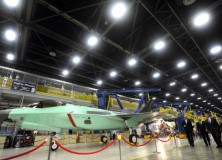Future Defense Industry Scenario — Sheila Ronis

INTRODUCTION:
In this future scenario, Chinese aggression towards Taiwan provides the impetus for Sino-U.S. military confrontation. During the beginning stages of conflict, the technologically superior and network-centric United States military is quickly devastated. The damage was not inflicted by conventional weapons, but was instead caused by electronic connectors – small, seemingly harmless connective devices used to join electrical circuits together, which are absolutely critical to everything using power. By activating imbedded programming in these electronic connectors, the Chinese are able to neutralize the defense, attack, and navigation capabilities within every system on U.S. ships, submarines, and aircraft. Because Beijing controls two-thirds of the world’s supply of these connective devices, the Chinese are able to infiltrate, deliberately and strategically, the U.S. military and industrial base and target four of the military’s primary weapons systems.
The purpose of this scenario is not to convince the reader that information and technological warfare with China are inevitable, but to expose flaws and weaknesses within the national security apparatus. This hypothetical case calls attention to potential dangers of not addressing current weaknesses in our defense industrial base and global supply chain. It also highlights the importance of evaluating assumptions and questioning the meaning of events in order to better prepare for the future.
STRATEGY:
For the last 30 years, through mergers, joint ventures, outright acquisition and industrial espionage, the Chinese have gained access to and control of sensitive technologies. This is especially true in the electronics industry. In this scenario, China’s control of electronic connector production, combined with the ability of Chinese manufacturers to provide a multitude of components for at least four critical weapons systems (both of which are realities) allows for extensive infiltration of the U.S. industrial and military supply base. The infiltration was made even easier because virtually all ocean-borne shipping servicing the industrial base supply chain was Chinese-owned, providing multiple opportunities to control or deny movement of components and permitting the Chinese to disrupt the supply chain at will.
INTEGRATED ELEMENTS OF NATIONAL POWER:
The military and economic elements of national power are ineffectively managed and integrated in this scenario. The major players in this type of situation include the Departments of State, Defense, Commerce, Treasury, Transportation, and the interagency Committee for Foreign Investment in the United States (CFIUS) process. All these actors, as well as Congress, influence how and where our weapon systems should be manufactured and how their supply chains should be managed. Unfortunately, the monitoring of the supply chain proves insufficient and issues like “electronic connectors” go unnoticed because they are considered commodities. Because no one is responsible for the “big picture,” no one is in the position to identify dangerous patterns as they emerge. In fact, there are no U.S. government personnel dedicated exclusively to overarching strategy with a long term view. In addition, high-impact, low probability contingencies are of little interest to busy politicians who have no immediate incentive to express concern or initiate change.
EVALUATION:
The contracting supply chain consists of tiers. The higher the tier, the closer the supplier is to the finished product. Depending on the number of times a given component goes from one supplier to another, the number of tiers increases. The production process can consist of as many as ten tiers, but currently the United States only documents prime and subcontractors to the fourth tier. Beyond that, it is next to impossible to develop additional supplier identification data. The Department of Defense does not require component origins identification beyond the third tier, making maintaining cohesion and program security within the manufacturing and supply base extremely problematic. In addition, in 1991 the Defense Department’s Strategic Acquisition Initiative made it a requirement for U.S. defense contractors to look first to COTS (Commercial Off-The-Shelf) products when developing new technology and upgrades. The motivation for using COTS components is that they will reduce overall system development costs and save development time since they can be bought instead of being manufactured from scratch.
RESULTS:
Gradual reductions in standards and shortsightedness have created extensive security systems compromises. National security vulnerabilities are literally built into our offensive, defensive and detection systems as economy and competitiveness, not security and performance, are the overarching parameters of Department of Defense supplier participation. In addition, the atmosphere created by the COTS mandate within the U.S. supplier base has led many to ignore the Berry Amendment, which calls for specialty metals critical to national security to be sourced only in the United States.
CONCLUSION:
This scenario is not about fantasy or prediction but practical reasoning and logical deduction. The root causes for failure are real, not imaginary. Weaknesses in our defense industrial base supply chain, dependency on third-party vendors, continual disregard for the Berry Amendment and lack of foresight regarding the interplay between global economy and national security are making the United States unnecessarily vulnerable to a wide range of potential dangers. Even though the threats that will emerge in the future are likely beyond our current commitments and contemplations, it would be a mistake to limit our ideas about the future by the narrow experiences of our past. While it can be dangerous to hold rigid beliefs about tomorrow, preparedness requires seeing possibilities before they become obvious and making wise decisions today.